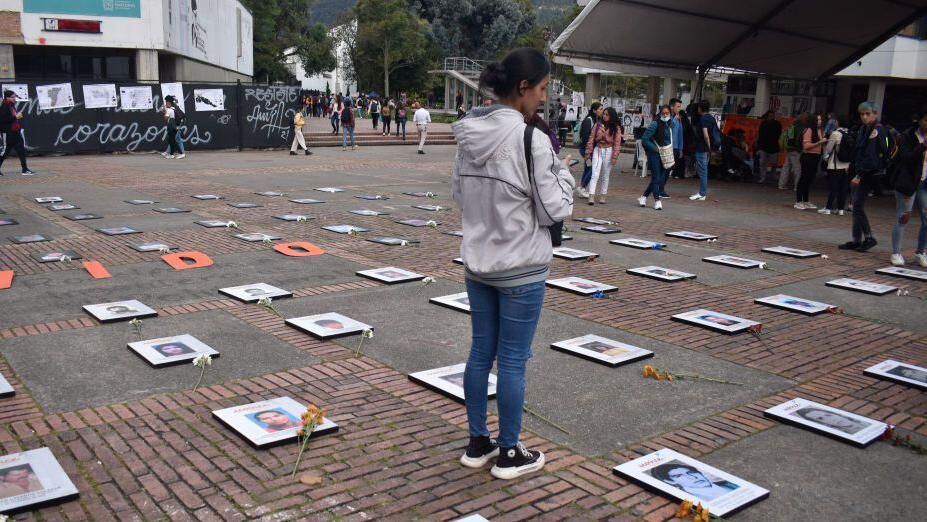In 1982, 13 young Colombians, most of them university students, were detained, tortured and disappeared by police forces.
On the 8th and 9th of April, 42 years after these events, the national university of colombia He symbolically gave university degrees to 4 of them.
LOOK: The “mutual care pact” between two nuns in Chile that ended with the body of one of them in a suitcase
“We searched every corner, knocked on every door, and exhausted every resource in our search desperate to find Humberto,” said Teresa Sanjuán upon receiving the title from her younger brother, Samuel Humberto.
In total, the university will symbolically graduate eight students who disappeared in 1982 due to an alliance between the F2a feared Colombian police intelligence structure that was dissolved in 1995, and the narco-paramilitary group associated with Pablo Escobar Muerte A Secuestradores (ADVANCE).
Samuel Humberto was arrested in Bogotá when he was 22 years old. I studied Anthropology. Since March 8, 1982, his family has not heard from him or his brother, Alfredo Rafael, a student of Architecture and Cadastral Engineering.
Alfredo and Humberto were student leaders. According to one of the many versions, they were the ones who painted the emblematic image of Che Guevara (which was erased and repainted dozens of times) on one side of the main square of the National University.
They are two of the 13 victims of forced disappearance whose families are grouped together in Collective Case 82.
Without previously knowing each other, the families of the 13 young people came together decades ago to create the Association of Relatives of Disappeared Detainees, dedicated to demanding that the missing be searched in Colombia.
In 1992, The Inter-American Commission on Human Rights held the State responsible for the disappearances. And in 2022 they were declared Crimes against humanity.
According to the Missing Persons Search Unit, there are more than 100,000 those disappeared in the context of the Colombian armed conflict.
The long struggle to obtain justice
The Truth Commission, an institution created by the Peace Agreement with the FARC to reconstruct the long Colombian conflict, described the Security Statute of the Julio César Turbay government (from 1978 to 1982) as a moment of intense stigmatization of left-wing university students by the State and public forces.
It was in this context that eight university students, three farmers, a mechanic and a tailor were detained, tortured and disappeared by F2 in Bogotá and Cundinamarca between March and September 1982.
They were accused, without any evidence, of involvement in the kidnapping and murder of the three children of drug trafficker José Jader Álvarez.5, 6 and 7 years old.
Four of them were linked to the criminal investigation.
Two of them ended up convicted. after having disappeared and, according to their lawyers, “without having held a fair trial in which they could defend themselves with all the guarantees”.
Since then, the victims’ families have accused José Jader Álvarez and law enforcement agents of collaborating in the disappearance of the young people.
The case was initially investigated by military justice. At least 20 police officers were attached, but in 1987 a police inspector decided to close it.
In 1992, the Inter-American Commission on Human Rights determined that The State was responsible for the disappearances and also decreed that the military justice system could not investigate the case because it involved serious human rights violations.
But it was only in 2008 that the Colombian Public Ministry requested a review of the case, recognizing that there was a “Prominent omission of the State’s duty to investigate”. In June 2011, the case was reopened, but since then there has been no progress in either sanctioning those responsible or searching for the young people.
On the 40th anniversary of the disappearances, Cajar, a group of lawyers who accompany the victims of Coletivo 82, called for the case to be declared a crime against humanity.
The Public Ministry did so after recognizing that the investigation is surrounded by “halo of impunity and apathy”.
A chapter that doesn’t end

Only two of the 13 missing from Coletivo 82 were found.
Teresa and Yolanda continue searching for their brothers, Alfredo Rafael and Samuel Humberto, and demanding justice.
“I would like to tell you that I carry your blood in my veins, your ideals in my head, your songs in my ears and your love in my life”, wrote Hilda Maritza, Teresa’s daughter, in a public letter to her uncles. who disappeared when she was just a girl.
Martha Ospina, daughter of another Colectivo 82 victim, wrote to her father’s missing: “I wish may your conscience touch and disturb you and lead you to tell the truth”.
The title that the National University grants to the eight missing people is a measure of reparation and a tribute to their families.
“It’s a fight so that the memory doesn’t disappear. These are tributes that should be paid only for his memory, because we no longer have“, expressed Teresa at the symbolic graduation of her brother Samuel Alberto.
The 13 missing from Collective 82 are Orlando García Villamizar, Pedro Pablo Silva Bejarano, Alfredo Rafael Sanjuán, Samuel Humberto Sanjuán, Rodolfo Espitia Rodríguez, Edgar Helmut García Villamizar, Gustavo Campos Guevara, Hernando Ospina Rincón, Rafael Guillermo Prado, Edilbrando Joya Gómez, Francisco Antonio Medina, Bernardo Acosta Rojas and Manuel Darío Acosta Rojas.
Source: Elcomercio
I am Jack Morton and I work in 24 News Recorder. I mostly cover world news and I have also authored 24 news recorder. I find this work highly interesting and it allows me to keep up with current events happening around the world.

:quality(75)/cloudfront-us-east-1.images.arcpublishing.com/elcomercio/5XR2MTSF5RCZRDUKEBH3EZONHE.jpg)

:quality(75)/cloudfront-us-east-1.images.arcpublishing.com/elcomercio/TICWSMXVBJCX5PQHSMOJPEONRY.jpg)
:quality(75)/cloudfront-us-east-1.images.arcpublishing.com/elcomercio/XX7FN3AZSNFNHOF24BXPDKTYAE.jpg)
:quality(75)/cloudfront-us-east-1.images.arcpublishing.com/elcomercio/YOMFVUBVHFA3XIQPKUA24SHNC4.jpg)
:quality(75)/cloudfront-us-east-1.images.arcpublishing.com/elcomercio/X7SRB6O6UFDMNFKVMXUPDFRIWA.jpg)
